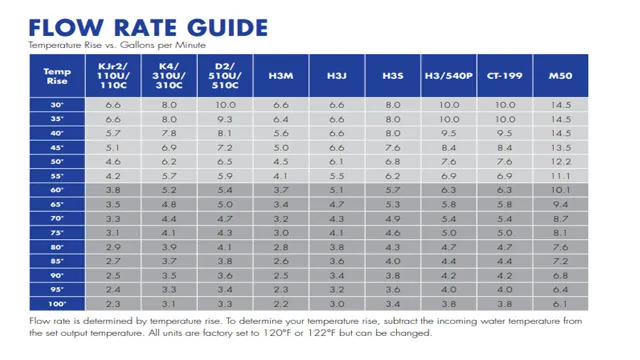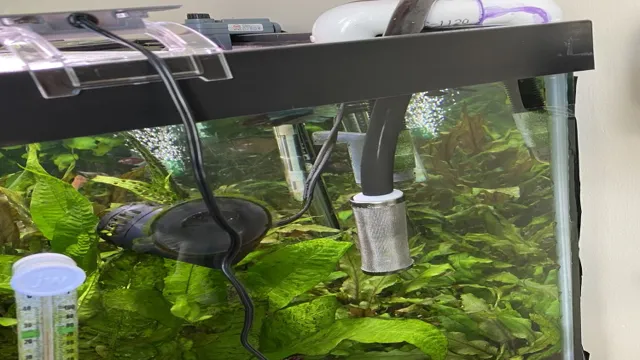As aquarium enthusiasts, we all want to create an ideal environment for our aquatic friends. One crucial aspect of maintaining a healthy aquarium is determining the flow rate. The flow rate measures how much water is cycling through your tank over a certain period, and it is essential to know to maintain the correct balance of water chemistry, temperature, and oxygen levels.
A low-flow rate can lead to stagnation and insufficient filtration, while a high-flow rate can exclude some species from being comfortable in their environment. In this blog, we will explain how to determine the flow rate in your aquarium and offer some tips on how to achieve a healthy balance for your aquatic friends. So, let’s dive in!
Understanding Flow Rate
Determining the flow rate in an aquarium is an essential step towards creating a healthy and balanced aquatic environment for your fish. By measuring the water flow rate, you can determine how much water is moving through your filtration system, making it easier to adjust the flow if necessary. To calculate the flow rate, you need to measure the volume of water that passes through the filtration system in a certain amount of time.
Water flow rate can be measured in gallons or liters per hour (GPH or LPH). One way to measure it is by using a flow meter or a flow gauge that can be easily attached to your aquarium filter. Additionally, you can also use a measuring cup or bucket with marked volume measurements and time how long it takes to fill the container.
Once you have this information, you can use it to make adjustments to your filtration system as needed, ensuring your fish have a clean and healthy environment.
What is flow rate and why is it important in aquariums?
Flow rate is a crucial aspect of aquariums that often gets overlooked by hobbyists. It refers to the speed at which water circulates through the tank, and it impacts everything from water quality to the health of aquatic life. In simple terms, flow rate describes how quickly water moves around the tank.
If the flow rate is too slow, debris and waste can accumulate in certain areas, leading to poor water quality and potentially harmful conditions for aquatic life. On the other hand, if the flow rate is too high, fish and other creatures may struggle to swim against the current and become stressed or fatigued. Finding the right balance is key, and regular monitoring of flow rate is essential for maintaining a healthy aquarium ecosystem.
By adjusting the rate of filtration and circulation, hobbyists can ensure that their aquatic life thrives in a safe and comfortable environment.
How is flow rate measured in aquariums?
Flow rate is a crucial aspect of maintaining a healthy aquarium. It refers to the amount of water that flows through the filter and back into the tank over a certain amount of time. Measuring flow rate is essential since under or over filtration can lead to poor water quality, which can harm your fish and plants.
Typically, aquarium enthusiasts measure flow rate using a flow meter or a flow sensor. A flow meter is a device that measures the amount of water flowing through it and displays the result on a screen. A flow sensor, on the other hand, uses a paddle wheel or a turbine to measure the water’s velocity and calculate the flow rate.
Aquarium owners should frequently check the flow rate to ensure it is at an optimal level according to their aquarium’s size and the types of fish and plants they keep. Keeping an appropriate flow rate helps to ensure a healthy and thriving underwater ecosystem for your aquarium’s inhabitants.
Calculating Flow Rate
If you’re looking to set up an aquarium, determining the flow rate is crucial. The flow rate is the amount of water that flows through your aquarium in a given time. To calculate flow rate, you will need a few tools such as a water flow meter, an aquarium pump, and a measurement container.
First, attach the flow meter to the pump and turn it on. Once the pump is running, set the measurement container underneath and allow the water to flow into it for a minute. After one minute, turn off the pump and measure the amount of water collected in the container.
The resulting measurement will give you the flow rate in gallons or liters per minute. A flow rate of around four to eight times the volume of your aquarium is recommended for proper filtration and oxygenation. By determining the flow rate, you’ll be able to adjust the amount of water in your aquarium, ensuring a clean and healthy environment for your aquatic pets.
Measuring Water Volume
Calculating flow rate is an essential aspect of measuring water volume. It is the measurement of the volume of water that flows through a specific section of a pipeline or river in a given time. Understanding the flow rate is crucial in determining the efficiency of a water system, helping in managing water resources, and preventing disasters, such as floods and droughts. (See Also: How to Get Rid of Aquarium Black Algae: Tips and Tricks for a Clean and Healthy Tank)
The formula for calculating flow rate is simple: Q=V/T, where Q stands for flow rate, V represents volume, and T denotes time. With this formula, one can determine the amount of water flowing through the pipe or river and its velocity. It is beneficial to know the flow rate as it helps identify if there are leaks in the system or if it is overworking, thus ensuring better water management.
When measuring flow rate, it is essential to use the appropriate measuring tools, such as flow meters, and ensure that the monitoring process is consistent and accurate. Overall, calculating flow rate is a crucial step in measuring water volume and promoting efficient water management.
Determine Time for Water to Travel a Specific Distance
Calculating the flow rate of water is essential when determining the time it will take for it to travel a specific distance. The flow rate is the volume of water passing through a particular point within a given time. It can be calculated in different units such as gallons per minute or cubic meters per second, depending on the measuring system in use.
To calculate the flow rate, you need to measure the volume of water and the time it takes to pass through the specific point. Once you have these measurements, you can then divide the volume of water by the time taken to get the flow rate. By knowing the flow rate, you can then determine the time needed for the water to travel a specific distance.
For instance, if you know the flow rate of a river that is two kilometers long, you can determine the time it will take for the water to travel the entire distance. Overall, calculating the flow rate is essential when determining the time it takes for water to travel a particular distance and can help you plan accordingly.
Calculating Flow Rate Formula
Calculating Flow Rate Flow rate is the measurement of how much volume of liquid or gas is moving through a particular point over a given period of time. Flow rate is commonly used in manufacturing plants, pipe networks, and plumbing systems to determine how much fluid or gas is being transported in a given amount of time. The formula for calculating flow rate is straightforward, given that you know the cross-sectional area of the pipe or channel, the velocity of the fluid or gas, and the time it takes to travel from one point to another.
Simply multiply the cross-sectional area by the velocity and divide by the time to find the flow rate in liters per second or cubic feet per minute. Understanding how to calculate flow rate is an essential skill for a range of industries, from chemical engineering to plumbing, and can help ensure efficient and safe operation of systems that transport fluids or gases.
Tools for Measuring Flow Rate
Determining the flow rate in your aquarium is important for maintaining a healthy aquatic environment. One of the tools you can use to achieve this is a flow meter. A flow meter is designed to measure the amount of water flowing through a particular area over a specific period of time.
There are different kinds of flow meters available in the market, including paddlewheel, electromagnetic, and ultrasonic flow meters. Paddlewheel flow meters are often the most commonly used type because they are affordable and easy to install. They work by using a wheel with several blades that spin as water moves through them.
Each turn of the wheel corresponds to a specific volume of water that passes through it. This data is then used to calculate the flow rate. Electromagnetic and ultrasonic flow meters are more expensive but are more accurate and can be used to measure flow rates in larger tanks.
No matter what type of flow meter you choose, it is important to calibrate it correctly and regularly to ensure accurate readings of your aquarium’s water flow rate.
Digital Flow Meters
Digital flow meters are essential tools used in measuring flow rates of liquids and gases. They are handy in all kinds of industries, ranging from food and beverage processing, pharmaceuticals, chemical manufacturing, and water treatment plants. These meters come in different styles, but they all serve the same purpose.
They use advanced technologies such as ultrasonic and electromagnetic to measure liquid and gas flow rates with precision. Unlike traditional flow meters that required manual readouts, digital flow meters provide real-time monitoring of the flow rate, which leads to better accuracy and efficiency. They are user-friendly and come with digital displays that help users interpret the results quickly.
Moreover, some digital flow meters come with wireless connectivity that allows users to monitor and control the flow rate remotely. In summary, digital flow meters are vital tools that help industries maintain optimal performance and efficiency in the operations. (See Also: How to Make an Aquarium Water Heater at Home – Easy DIY Steps)
Flow Grids
Flow grids are a type of tool used to measure the flow rate of liquids and gases. They consist of a series of small tubes or channels that are placed at right angles to the flow direction. The fluid being measured flows through the channels, causing pressure to build up across the grid.
By measuring the pressure drop across the grid, the flow rate of the fluid can be calculated. Flow grids are commonly used in engineering and industrial applications, where precise flow measurement is required. They can be used in a wide range of operating conditions and can be designed to measure a wide range of flow rates.
With their high accuracy and reliability, flow grids are an essential tool for measuring fluid flow in a variety of applications.
Paddlewheel Flow Sensors
When it comes to measuring flow rate, there are several tools available, one of which is the paddlewheel flow sensor. This sensor utilizes a rotating wheel that is attached to a shaft and placed in the fluid stream. As the fluid flows past the wheel, it causes the wheel to rotate, and the rotation speed is proportional to the flow rate.
The sensor can then measure this rotation frequency and calculate the flow rate. Paddlewheel flow sensors are commonly used in applications such as water treatment, HVAC systems, and industrial processes. These sensors are reliable, accurate, and easy to install, making them a popular choice among engineers and technicians.
By utilizing paddlewheel flow sensors, industries can ensure optimal performance and reduce costs associated with maintenance and downtime.
Maintaining Ideal Flow Rate
If you want to keep your aquatic pets healthy and happy, it’s important to maintain the ideal flow rate in your aquarium. But how do you determine the proper flow rate? The answer depends on a few factors, including the size and shape of your tank, the types of aquatic life you have, and the filtration system you’re using. Generally, you want to aim for a flow rate of 5-10 times the volume of your tank per hour, but this can vary depending on your specific situation.
One way to determine the flow rate is to use a flow meter or anemometer, which can measure the velocity of the water coming out of your filter or powerhead. You can also experiment with different flow rates to see what works best for your particular aquatic ecosystem. Remember, maintaining the proper flow rate is critical for ensuring good water circulation, preventing dead spots, and keeping your fish and plants healthy.
So take the time to find the right balance and give your aquatic pets the best possible care.
Effects of High and Low Flow Rates on Aquariums
Maintaining Ideal Flow Rate in Aquariums for Optimal Health and Well-being of Fish The water flow rate is an essential aspect of an aquarium, as it directly affects the health and well-being of the aquatic creatures. High flow rates can create strong currents that may be harsh on certain fish and invertebrates, while low flow rates can result in stagnant water and build-up of pollutants. As an aquarium owner, it is crucial to maintain an ideal flow rate that suits the needs of your fish and other inhabitants.
A good rule of thumb is to aim for a turnover rate of four to ten times the volume of the tank per hour. For instance, if you have a 50-gallon aquarium, then your filter should ideally pump water at a rate of 200-500 gallons per hour. However, it is essential to consider the types of fish and plants in your tank before deciding on the flow rate.
Some species of fish prefer calmer waters, while others require strong currents to simulate their natural habitats. For example, discus fish and bettas prefer low flow rates, whereas cichlids and barbs need a higher flow rate to stay healthy. Similarly, some plants require gentle water movement, while others thrive in strong currents.
In addition to the type of fish and plants, the size and shape of your aquarium also play a significant role in determining the ideal flow rate. A tall, narrow tank requires a lower flow rate than a wide and shallow tank to ensure proper water circulation. Moreover, placing rocks, ornaments, and driftwood strategically in your tank can help create natural barriers to direct the flow of water.
Maintaining the ideal flow rate in aquariums is essential for the health and well-being of your fish and plants. By considering the type and size of your aquarium and the requirements of its inhabitants, you can ensure optimal water circulation and filtration. Regular maintenance and cleaning of your filter and water pump also help prevent build-up of debris and pollutants, ensuring a healthy and thriving aquatic ecosystem. (See Also: How to Grow Moss for Aquarium: A Complete Guide to Stunning Aquascapes)
Adjusting and Maintaining Flow Rate for Optimal Aquarium Health
Maintaining ideal flow rate is crucial for the health and well-being of your aquarium inhabitants. Water movement is essential for distributing nutrients, oxygen, and waste removal, but too much or too little flow can be harmful. Optimal flow rate varies based on the type of aquarium you have.
A heavily planted tank will require less flow than a reef tank, for example. To maintain ideal flow, start by choosing the right circulation pump and placing it strategically in the tank. You can also use powerheads and wave makers to create different flow patterns and currents.
Regular maintenance is also necessary to ensure optimum flow rate. Clean your equipment and adjust flow rates as needed to optimize aquarium health. Remember, just like Goldilocks and the three bears, you want a flow rate that is not too hot, not too cold, but just right.
Conclusion
In conclusion, determining the flow rate in your aquarium is vital for maintaining a healthy aquatic environment. By using a simple formula and measuring tools, you can ensure that your fish and plants receive the proper amount of water flow and oxygenation. Remember, don’t let the flow rate be a mystery – get your aquarium flow rate flowing smoothly and your aquatic friends will thank you for it!”
FAQs
What is flow rate in an aquarium and why is it important?
Flow rate in an aquarium refers to the amount of water that passes through the filtration system and back into the tank. It is important because it helps maintain water quality, ensures proper oxygenation for aquatic life, and helps distribute nutrients evenly.
How do you calculate the flow rate in an aquarium?
To calculate the flow rate in an aquarium, measure the water that flows into the aquarium over a set time period (such as one minute) and multiply that by 60 to get the gallons per hour flow rate.
What is the ideal flow rate for a freshwater aquarium?
The ideal flow rate for a freshwater aquarium is typically between 5-10 times the volume of the tank per hour. For example, if you have a 50 gallon tank, the flow rate should be between 250-500 gallons per hour.
Can a high flow rate harm aquarium fish or plants?
Yes, a high flow rate can harm aquarium fish or plants if it’s too strong. Strong currents can stress fish, damage their fins, or make it hard for them to swim. High flow can also uproot plants and disturb their growth.
How can you adjust the flow rate in an aquarium?
You can adjust the flow rate in an aquarium by using a flow control valve or adjusting the equipment that generates water flow, such as a powerhead or filter.
Is a low flow rate bad for an aquarium?
Low flow rate can be bad for an aquarium as it can cause stagnant water, poor water quality, and inadequate oxygenation. It can also lead to dead spots where debris accumulates.
Do all aquariums need a flow rate measurement?
Yes, all aquariums need a flow rate measurement to maintain the optimal environment for aquatic life. It is essential to keep the water moving and flowing to prevent stagnation, maintain oxygen levels, and promote a healthy ecosystem.







